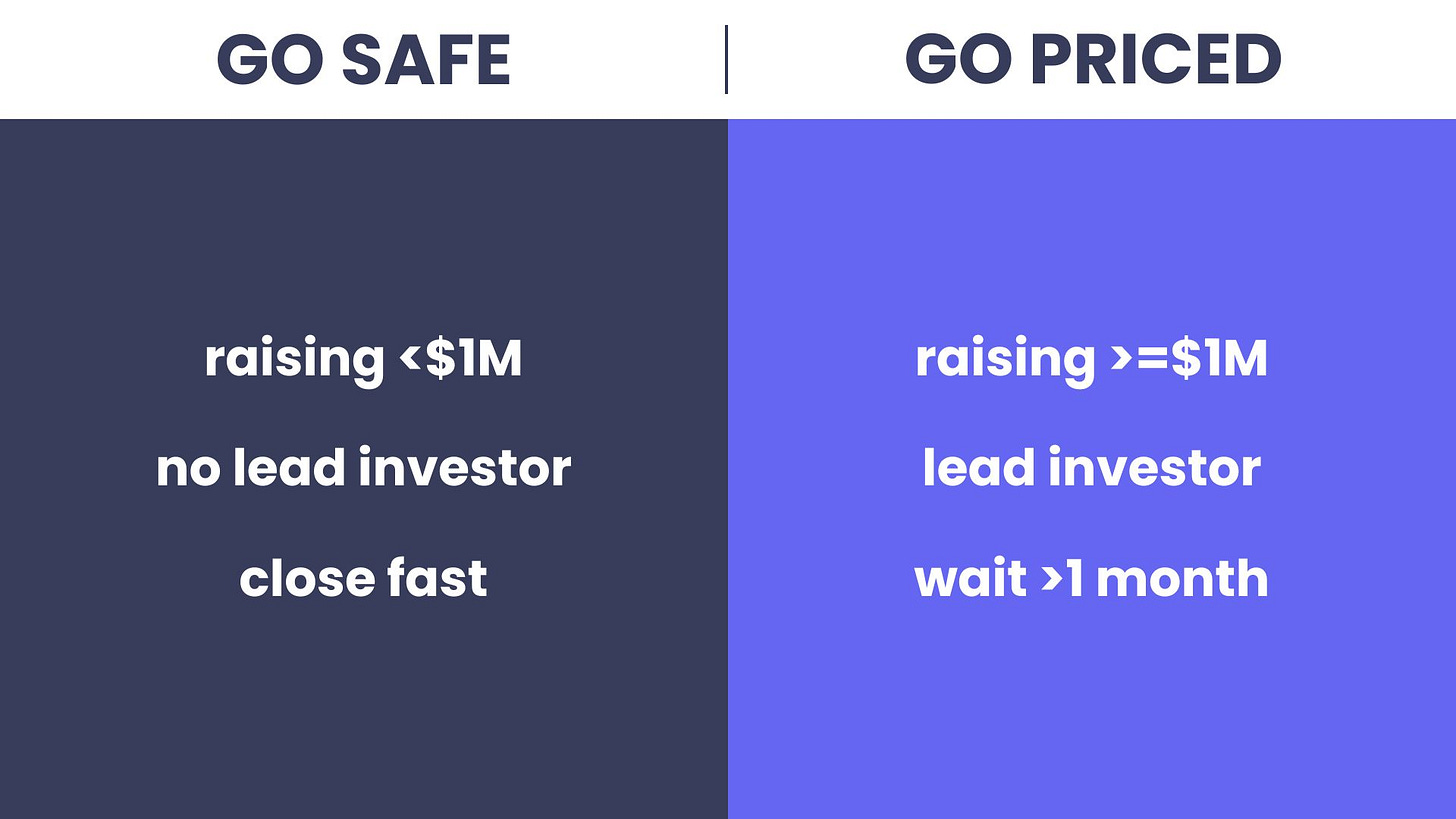Safe round or priced round? That is the question.
Simple rules to help you make the call when raising a round.
Tl;dr: Raising less than $1M, without a lead investor, and need to close checks fast? Do a Safe round. Raising $1M or more, with a lead investor, and don’t mind waiting a few weeks? Go with a priced round.
Hey there! So great to have you on the founder memo newsletter, where I share stories every other week about founders and their legal journeys in order to help you on yours. When you have a moment, please let me know what you think! Getting your feedback will help me understand if I’m providing value to you.
Why bother doing a priced round?
“So, how much are you raising,” I asked my founder friend whom I bumped into at an event.
“Two”, he offered casually. He meant $2 million.
“Doing a priced round?”, I replied, pretty sure the answer was going to be affirmative.
“Why bother? We’re doing safes.”
“Why though?”
“It’s cheaper and easier,” he said matter-of-factly.
“Look, let’s talk about this. You’re likely better off doing a priced round.”
That’s when it hit me.
This topic – the one of “Safe round vs. Priced round” – isn’t being talked about as much as it should, and founders are reflexively deciding to go with Safes.
That's the default option… “why bother” doing a priced round?
And that prompted me to write this week’s newsletter.
So here we are.
Rules of Thumb: Safe Round vs. Priced Round
Here are high-level factors to consider when making the call between a safe round and a priced round for your next fundraise.
Raising less than $1M vs. raising $1M or more
It’s simple economics. A Series Seed priced round is going to set you back at least $30K-$50K – often, substantially more. If you’re raising an angel round of $500K, dedicating 10% of that to legal fees just don’t make sense. Instead, do a safe round.
Raising $2M? That’s a different matter. In fact, all else being equal, a $10M raise is going to cost just about as much as a $1M raise in terms of a priced round – so the larger the round, the more it makes sense to do a priced round.
No lead investor vs. lead investor
$1M or more is a lot of money. If you’re raising that much, you likely want to have a lead investor: an investor that will put in a big chunk of the round (say, $1M out of a $2M target raise) and serve as an anchor to raise the balance. In other words, if you have a lead investor, you should have an easier time raising your round, which shifts the decision needle to doing a priced round.
On the flip side, if you don’t have a lead investor, you’re probably in for a longer fundraise. Even if the round is substantially smaller – say, $500K – raising that amount with smaller checks is going to take a while. In such cases, you’re probably better situated to do a safe round.
Close fast vs. wait weeks
Safes are notoriously simple, which is the core reason they’ve skyrocketed in popularity. One document, about seven pages long – fill in a few uncontroversial fields, sign, get the wire, done (kinda). Going from handshake to money in the account normally takes a few days tops. If you’re short on time and need to close checks fast, do a safe round.
Priced rounds are a different animal. Partly due to the rise in Safes, priced rounds got kicked down the startup lifecycle, eventually resulting in more complex rounds. The NVCA forms – formerly reserved for Series A deals and beyond – have crept into Series Seed raises as well. Five documents, cumulatively 50+ pages long, heavily negotiated – you can imagine that taking that paperwork from draft to done is going to take much (much, much) longer than a Safe. Have a few weeks to spare? Do a priced round.
Pros and Cons of Safe vs. Priced
Obviously, both safe rounds and priced rounds have their pros and cons. Here’s a quick overview of each.
Safe rounds
Pros
Simple: You probably already picked up on this, but to recap: Safes are a relatively simple instrument. One document with only a handful of uncontroversial fields to fill in, all of which are either objective info (such as the investor’s name or address) or a negotiated business term (such as the applicable discount or valuation cap).
Fast: As a result of this simplicity, Safes can be closed very fast – usually within a few days of coming to terms.
Cheap: They’re also relatively inexpensive to turn around. While you should definitely have a check-in with a competent lawyer when raising a safe round, you probably don’t need a lawyer’s guidance for each and every safe you close.
Cons
Investor education: Being a relatively new construct and not falling squarely within two main corporate finance buckets (debt and equity), safes can sometimes require educating investors about their dynamics to make sure they’re entirely comfortable with this instrument. In fact, lots of investors (and attorneys, for that matter) continue to resent safes and instead prefer convertible notes or priced rounds.
Anti-dilution: The post-money valuation cap safe, which has emerged as the fairly ubiquitous version of safe for early-stage fundraising, has a built-in anti-dilution clause. Essentially, the stock ownership that is committed to investors under this safe version remains isolated from dilution until and unless the company does a priced round. I dive deep into this landmine in “Is it SAFE?”.
Opaque ownership: Since you’re not (yet) issuing stock with a Safe, it’s easy to lose track of how much of your company you’ve given away in each round – or, worse yet, not be able to calculate it altogether. The equity ownership of each Safe investor becomes clear only when their investment converts into stock at a priced round.
Priced rounds
Pros
Clear relationship: With dozens of pages of contracts, it’s no surprise that the rights and relationship between the company and its investors are clearly defined in a priced round. Voting rights, information rights, liquidation preference, and so forth – everybody knows exactly who owes what to whom.
Company valuation: By definition, a priced round sets a company valuation, which is why it’s called “priced”. The magic here is that you finally know how much your company is actually worth, which comes in particularly handy when incentivizing new hires with equity grants: you can now put a dollar figure on the grant they’re getting (note that with a Safe, the most you can get is a “valuation cap”, which just isn’t the same).
Due diligence: “Gosh, I love due diligence” said nobody ever. But the fact of the matter is that "due diligence” is the hard medicine that does you right. First your attorneys – and then your investors’ attorneys – scour over your legal documents in order to find holes in them: the former to fix them, and the latter to ask the former to fix them. Once you’re through with this, you emerge as a pristine, legally solid company, and that in itself is a blessing. You just don’t get the same level of due diligence with Safe rounds.
Cons
Complicated: Have you seen the NVCA financing forms? Go ahead, check them out here. The 50+ pages I mentioned above… well, that’s after you’re done cleaning up all the irrelevant brackets in each of those documents. Originally, each document itself could be that long. And removing the irrelevant brackets is one part of the job; the language that does remain is then heavily negotiated…
Long: …which usually results in a weeks-long process to go from term sheet to money in the account. Running an internal health check, setting up a data room, undergoing due diligence, and negotiating and finalizing the financing documents (especially as to disclosures, which are essentially the exceptions that you give your investors heads-up on, such as if certain of your employees never signed an IP assignment) can take a while.
Expensive: With all that, no wonder that priced rounds can cost a pretty penny. Assuming you don’t have to pick up your investors’ counsel’s bill, you’re still easily looking at a $25-$30K bill. That being said, important to re-emphasize here that sometimes, it’s better to eat up that bill now and do a priced round than do a Safe round instead and “pay up” millions of dollars in founder equity value later on (more, here).
Conclusion: When raising, be reflective – not reflexive
At the end of the day, I feel like the formula should be switched: rather than thinking of Safes as the default option and priced rounds the exception, it is priced rounds that should be the default go-to and Safe rounds the exception.
In any case, don’t make the call based on “word on the street”. That can result in you being penny-wise but pound-foolish. Use the rules of thumb above to educate yourself on your options, talk with a competent startup lawyer, and act accordingly (and with confidence).
Shameless plug: whether you’re raising a Safe round or a priced round, my startup, Corpora, has got you covered.
Startup Ecosystem Member Highlight
Over the past years, I’ve had the opportunity to meet with amazing people who are super passionate about startups. I’d love to introduce them to you through this newsletter, as they can be helpful to you as you start, grow, and scale your startup.
Meet Armine Galstyan
Armine is the managing director of Hero House, a vibrant, founder-focused entrepreneurship hub serving the startup scene of Southern California. She is also a principal at Smartgate VC, the founder of Hero House.
But “vibrant, founder-focused entrepreneurship hub” just doesn’t capture the awesome-ness of this space: you have to be there in order to really get a sense of it. Part of Glendale’s ambitious vision for turning the city into a go-to tech startup scene, Hero House holds regular talks about topics entrepreneurs care about: fundraising, marketing, product, and more. Each such event draws a crowd of founders, investors, attorneys, CPAs, and other startup-facing professionals, creating an environment very much alive with insight and inspiration.
In short, Hero House hits all the right points when it comes to supporting early-stage startups and incubating the local startup scene. And Armine is the facilitator behind it all.
Connect with her on LinkedIn, and subscribe to Hero House’s updates on their website!
Liked this content?
Let me know! You can do that by dropping me a line, commenting below, subscribing, sharing this with a friend, or just giving me a “high five” by liking this post.
Have a great weekend,
Stepan
A bit about me: I’m a corporate lawyer with 10+ years of experience helping 100s of companies navigate the legal journey, including early-stage startups and unicorns. I quit my private practice to start Corpora and help founders raise money faster and more affordably. Let’s connect on LinkedIn.







